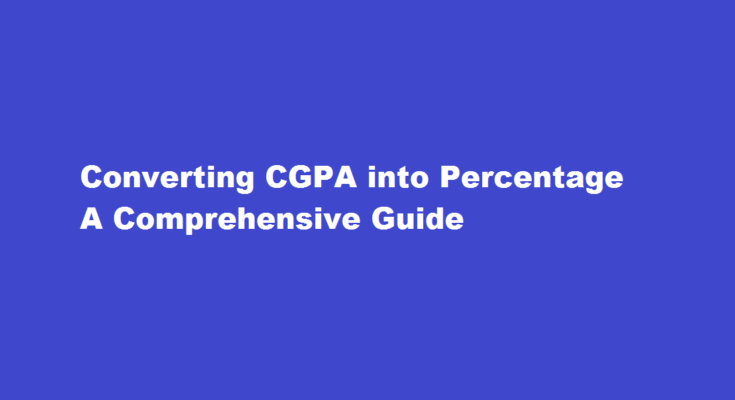Introduction
In the academic world, two common grading systems are prevalent: the Cumulative Grade Point Average (CGPA) and the Percentage system. While CGPA offers a holistic view of a student’s overall performance, certain situations require conversion to the percentage format. This article aims to provide a comprehensive guide on how to convert CGPA into a percentage accurately. By understanding the conversion process, students, educators, and employers can effectively interpret academic achievements and make informed decisions.
Understanding CGPA
CGPA is a grading system that assesses a student’s performance over a specific period, usually an academic year. It is a cumulative average of the Grade Points obtained in each course, weighted by their respective credit hours. The grading scale typically ranges from 0 to 10 or 0 to 4, depending on the educational institution. The CGPA format allows for a comprehensive evaluation, as it considers the entire academic performance rather than focusing solely on a single examination or semester.
Conversion Formula
To convert CGPA to a percentage, it is crucial to determine the equivalent range for each grade point. The specific conversion formula may vary across institutions, but a commonly used approach is:
Percentage = (CGPA – 0.5) x 10
For instance, if a student has a CGPA of 8.2, the conversion would be as follows:
Percentage = (8.2 – 0.5) x 10 = 77%
This formula considers the midpoint of each grade point range, providing a fair representation of the student’s performance.
Important Considerations
While the above formula is widely used, it is essential to note that institutions may have different conversion methods. Some universities might use a linear mapping of grade points to percentages, where each grade point represents a fixed percentage increment (e.g., 10% for each grade point). It is advisable to consult the specific guidelines provided by the educational institution to ensure accurate conversion.
Additionally, certain universities or employers may request a more precise conversion by considering the credit hours of each course. In such cases, the weighted average method is employed. The weighted average takes into account the credit hours assigned to each course and calculates the CGPA accordingly, which can then be converted into a percentage.
Another factor to consider is the rounding-off procedure. Institutions may have different policies regarding rounding. Some may round off the final percentage to the nearest whole number, while others may consider decimal places for greater accuracy. Familiarising yourself with the rounding-off policy of the respective institution is essential to avoid discrepancies.
FREQUENTLY ASKED QUESTIONS
What percentage is 7.6 CGPA?
For instance, multiply 7.6 CGPA by 9.5 to get a percentage; the resulting value, 72.2, is the percentage.
What is the formula for converting CGPA to percentage?
The CGPA to percentage conversion is as simple as multiplying your CGPA by 9.5. This formula is available on the CBSE’s official website for students in grades IX and X. For example, if you had a 9.4 cumulative grade point average (CGPA), the comparable percentage would be 9.4*9.5 = 89.3%.
What percentage is 9.7 CGPA?
The result and conversion of 9.7 CGPA into percentage will be 92.15%. To know the percentage from CGPA, the formula goes by 9.5×CGPA. For understanding consider the following example, 9.7×9.5= 92.15% 9.7 being your CGPA and 92.15% being your result of the conversion.
Conclusion
Converting CGPA to a percentage is necessary in various scenarios, such as applying for higher education or seeking employment opportunities. While the widely used formula (Percentage = (CGPA – 0.5) x 10) provides a reasonable approximation, it is crucial to consult the specific guidelines provided by the educational institution to ensure accurate conversion. Additionally, considering factors like credit hours and rounding-off policies can further enhance the precision of the conversion. By understanding the process and considering these important factors, students, educators, and employers can confidently interpret CGPA scores in percentage terms, facilitating effective decision-making.
Read Also : Connecting Your Phone to Your TV A Guide for Seamless Integration



